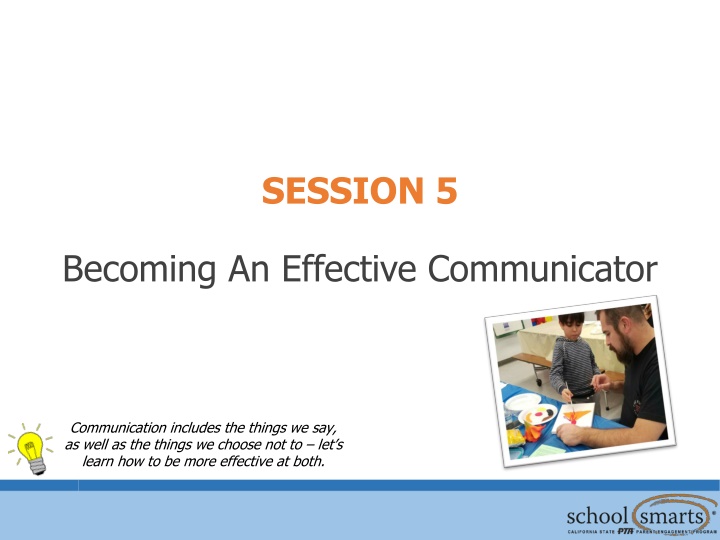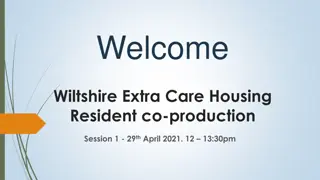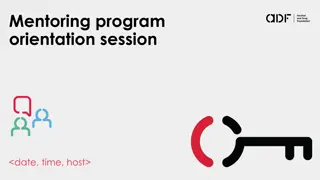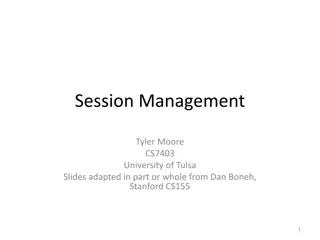
Effective Communication in Home-School Relationships
Learn the importance of communication in home-school relationships, discover communication basics, recognize barriers to effective communication, and understand how clear communication can benefit your child's education. Enhance your skills to build strong connections with your school community for a successful academic journey.
Download Presentation

Please find below an Image/Link to download the presentation.
The content on the website is provided AS IS for your information and personal use only. It may not be sold, licensed, or shared on other websites without obtaining consent from the author. If you encounter any issues during the download, it is possible that the publisher has removed the file from their server.
You are allowed to download the files provided on this website for personal or commercial use, subject to the condition that they are used lawfully. All files are the property of their respective owners.
The content on the website is provided AS IS for your information and personal use only. It may not be sold, licensed, or shared on other websites without obtaining consent from the author.
E N D
Presentation Transcript
SESSION 5 Becoming An Effective Communicator Communication includes the things we say, as well as the things we choose not to let s learn how to be more effective at both.
Session 5 Objectives In this session you will learn 1. Why home-school communication is so important 2. How to build strong communication skills How well do you think you communicate? What are your strengths and areas for improvement with communication? Graduation is right around the corner! Remember, you need to attend 5 sessions to receive a certificate.
Why is home-school communication so important? Communication is the most critical ingredient of a healthy long term relationship. Did you know that you will be in nearly daily contact with your school community for a minimum of 13 years? This is a long term relationship worth investing your time and energy. Clear communication in a school environment can help you: Understand what and why things are happening at school Handle difficult situations Clarify information you may be receiving Get additional information on issues Find out about opportunities to help your child Ensure full support by teachers and administrators Help you build relationships and community with other families at school Communication not only involves speaking clearly, but also listening well. PG. 1
A quick review of some communication basics Communication begins with a person who has a message to share with others. That message is shaped by the person s experiences and values. On the receiving end, the message is then interpreted through the experiences and values of the listener. Can you see how a breakdown in communication might occur? To be an effective communicator, your goal should be to make each stage of the process as clear and simple as possible. Be clear about the why, what, and who of your message. Make sure the information is useful and accurate start with a clear idea about what your message is, then put it into words that are clear and appropriate for your audience. Consider age, background, life experiences, needs and values of your audience Choose the best form of communication (verbal, written) Speak, but also listen and be aware of the other person s perspective. Pay attention to verbal and non verbal reactions so you know whether your message is received. Messages can be spoken, written or nonverbal, and can be sent via a variety of media. PG. 1
Barriers to effective communication When effective communication doesn t happen, some likely possibilities are: The message sender didn t take into account how the receiver would hear what was said. The sender s information was confusing or incomplete. The sender sent so much information that the receiver was overwhelmed. The method of communication wasn t the best choice (e.g. a phone call at a busy time of day). The receiver didn t communicate their concerns adequately. In school communities, communication challenges exist, including: Logistical issues Cultural or language barriers Legal constraints related to educational rights or privacy Effective school communication takes commitment from all members of the school community. PG. 2
Home-school communication How do schools communicate with parents? Schools are legally bound to provide information that is clear and accessible to parents. In most schools, communication is provided in the following ways: Letter from the principal Progress reports, test scores, and school wide assessments Parent Portal on school/district website Principal or teacher newsletter and event fliers Signs and banners Automated telephone calls or regular phone calls Emails Text messages Websites Have you registered for your district s parent portal yet? This is a valuable communication tool! PG. 3
Home-school communication Schools also provide many opportunities for parents to communicate and interact on campus: Back-to-School Night Parent-Teacher Conferences Open House School events, festivals, special programs Personal appointments with teachers or administrators Parent groups who hold meetings like PTA, SSC, ELAC, garden club Have you had a positive experience with home school communication? Share your success! The Family-School Partnership Act is a California law that allows parents, grandparents and guardians to take time off of work to participate in their child s school or childcare activities. Be sure you update the school with any contact information that might have changed. PG. 3
How can parents better communicate? At school: At the start of the year, introduce yourself to your child s teacher. Share your contact information and let them know you re committed to supporting your child. Don t only communicate when there are problems share the successes too! When you have a school issue, start with the teacher. Set up an appointment for a time that is good for both of you. If you need more assistance, honor the levels of authority. If you speak a language other than English, request an interpreter so your message is clear. With one another: Building relationships with other parents is so important for support and friendship Find the most clear, inclusive way to communicate (face-to-face, phone, email, text, etc.) Participating in organizations like PTA promotes positive parent-to-parent and parent-to-school communication. PG. 4
Cultural considerations in communicating at your school We make our schools better places when we communicate, share our similarities and differences, and take action because we recognize some of us need additional help. When building communication bridges as a parent leader in your school: Get to know other parent s interests, skills, and talents. Find out the ways parents in your community like to communicate and consider what methods work best for families. Publicize meetings so everyone can attend. Translate materials. Introduce people at gatherings so parents feel welcomed and included watch for parents that need a little encouragement to speak up. Tell your stories and share details about your life. If needed, bring communication training (like School Smarts!) to your school. Work with your school leadership to ensure that communications are culturally sensitive. PG. 5
Legal considerations that impact how schools communicate Schools must follow legal requirements and procedures to protect student/family privacy. The Family Educational Rights and Privacy Act (FERPA) is a federal law that gives parents certain protections with regards to their children s education records. It also: Gives parents the right to review their child s education record and request changes Generally requires schools to ask for written consent before disclosing personal information to anyone other than a parent Ensures when a child turns 18 or attends school beyond high school, the rights transfer to the student Schools are allowed to disclose certain records, without parental consent to a select group of individuals including school officials, accrediting organizations, or with judicial order and in cases of health and safety emergencies. Schools may disclose directory information without consent, but must first allow parents to opt-out. PG. 6
Building effective communication skills Active listening ismaking a conscious effort to hear not only the words a person is saying, but more importantly, trying to understand the total message. Follow these five steps to become a better active listener: 1. Pay attention. 2. Show that you are listening. 3. Provide feedback. 4. Don t interrupt. Do defer judgement. 5. Respond appropriately. Most people remember only 25-50% of what they hear. Listening is one of the most important skills you can develop. Make an effort to be an active listener this week and see what happens! If you find yourself responding emotionally to what someone said, say so, and ask for more information. PG. 7
How can you tell if good communication is happening? You can tell good communication is happening when a school community is engaged. Does the principal welcome families and meet with parents in small groups or one-on- one? Do school staff and the PTA have programs to connect parents with one another? Do parents know how to raise questions at school and within the district? Are strategies in place to help parents resolve concerns? Do parents and school leaders work closely to support students. If communication within your school community is less than ideal consider asking: Are families feeling comfortable and are their voices being heard? Do they believe the school/district takes their concerns seriously? Do parents agree with the steps being taken? Do teachers feel respected for their work? Never stop paying attention. Never stop communicating! PG. 8
Digital literacy for parents, students and schools The digital age is revolutionizing the way children learn and communicate. It is essential for students and their parents to become digitally literate and know how to use and navigate the Internet and social media effectively and safely. Some things for parents to know: Federal, state, and local laws and policies are in place to regulate how the Internet can be accessed and used at School. Digital literacy is a part of your child s education and included in the Common Core Standards. Parents need to understand technology for their own use and to monitor their children. Rules and boundaries need to be established at home for safe and secure use of social media. Many districts offer digital literacy training programs for parents. Contact your district office, library, or community center. Get trained and informed! Do you have rules at home regarding social media/digital use? Visit Californiahealthykids.org for free materials on Internet safety and other topics. PG. 9
Building good parent-child communication Creating a family environment where open, honest, respectful, two-way communication is the norm among all family members is one of the best ways to ensure your child s success in school and in establishing healthy lifetime habits. Building strong communication with your child is vital, and an investment that will be rewarding for both you and them. Children thrive on positive attention, so look for daily opportunities to sincerely encourage or praise your child. They may even start paying more attention to you and trying harder to please. Review and discuss pg. 10 16 ways to build strong communication with your child. What are your greatest challenges when communicating with your child? What are your greatest joys? Praise your child. Even a high-five will do! PG. 10-11
Session 5 Wrap-Up and Homework Successful communication: Covers timely and meaningful subjects Is considerate of the needs of everyone Avoids blaming Is based on honest representation of thoughts, ideas and situations Makes sure everyone can participate in the dialogue Involves listening as well as talking Happens often Try one or two strategies for communication with your child. Review the Potential Topics Parent Can Advocate For on pg. 20 as we prepare to discuss Action Planning. Our next academy date is: Review Session 5 handouts for information on public speaking, presentation skills, and a checklist to guide you in Parent-Teacher conferences. PG. 12
One Final Touch If a child lives with criticism, he learns to condemn. If a child lives with hostility, he learns to fight. If a child lives with ridicule, he learns to be shy. If a child lives with fear, he learns to be apprehensive. If a child lives with shame, he learns to feel guilty. If a child lives with tolerance, he learns to be patient. If a child lives with encouragement he learns to be confident. If a child lives with acceptance, he learns to love. If a child lives with recognition, he learns it is good to have a goal. If a child lives with honesty he learns what truth is. If a child lives with fairness, he learns justice. If a child lives with security, he learns to have faith in himself and those about him. If a child lives with friendliness, he learns the world is a nice place in which to live to love and be loved. -- anonymous PG. 22
Art Activity 1: Session 5 Making Hats: The Different Ways we Express Ourselves Overview: You will create a hat that represents two or three significant roles you play. What we ll learn: Role playing and sharing with the group use the power of theatre to build trust and respect. The topics used in the role playing also model how you can use your knowledge in the school and larger community. Let s brainstorm some the hats we wear or the different roles/tasks we perform. See Art Activity handout in Session 5 for detailed instructions. PG. 13
Art Activity 2: Session 5 Chatterbox Game Overview: In an origami-like project, you will fold and label a chatterbox children s game for an activity that is both fun and helps create discussion about some of the different ways we communicate. What we ll learn: Adapts a form of origami (originally used in children's games), that can be used to play a communications game. The game engages us in using different communication media to deliver the same message which then leads to a group discussion of the strengths and challenges of different communication methods. See Art Activity handout in Session 5 for detailed instructions. PG. 14-16



















